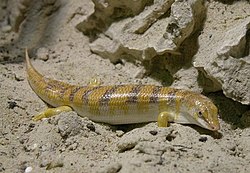| Scincus | |
|---|---|
 | |
| Scincus scincus , common skink or common sandfish | |
| Scientific classification | |
| Kingdom: | Animalia |
| Phylum: | Chordata |
| Class: | Reptilia |
| Order: | Squamata |
| Family: | Scincidae |
| Subfamily: | Scincinae |
| Genus: | Scincus Laurenti, 1768 |
| Species | |
Five, see text. | |
Scincus is a genus of skinks, lizards in the family Scincidae. The genus contains four or five species, all of which are typical desert inhabitants, living in sandy and dune-like areas with a hot and dry climate. Species in the genus Scincus can be found from Arabia to the Sahara desert.



